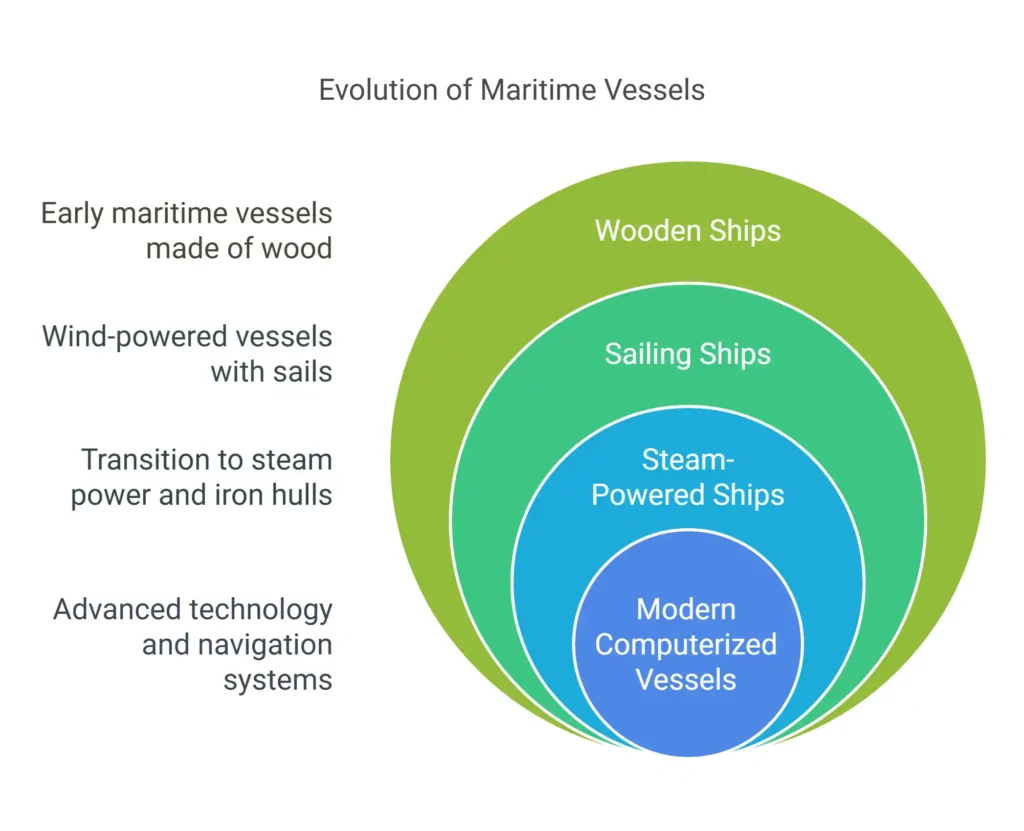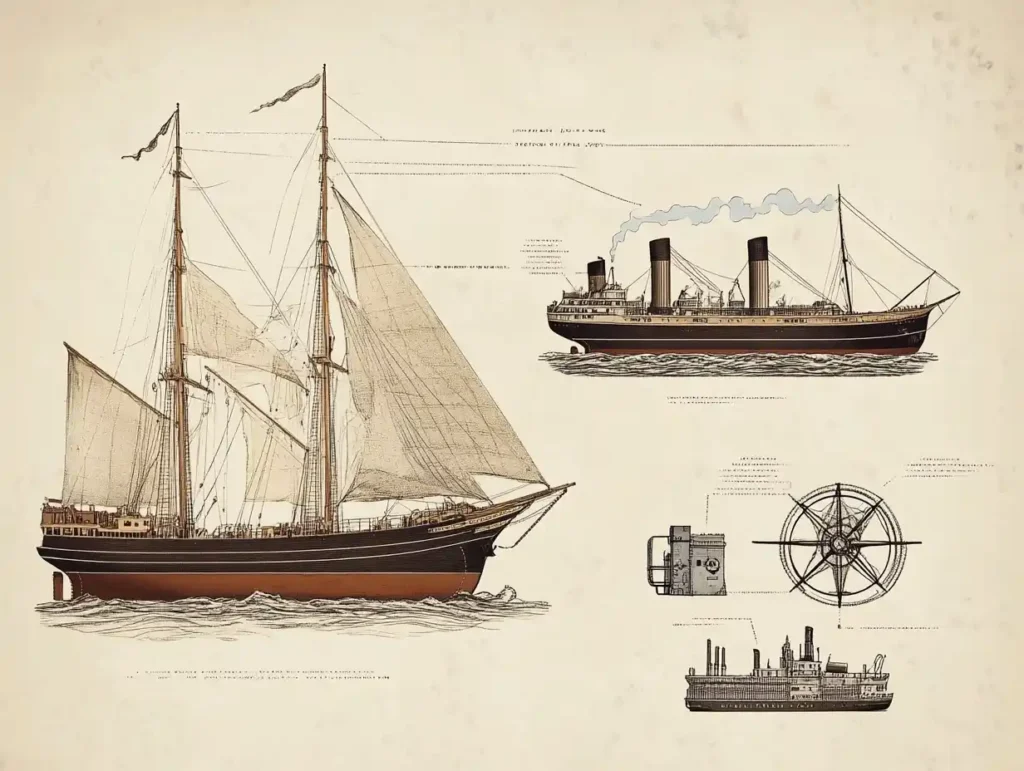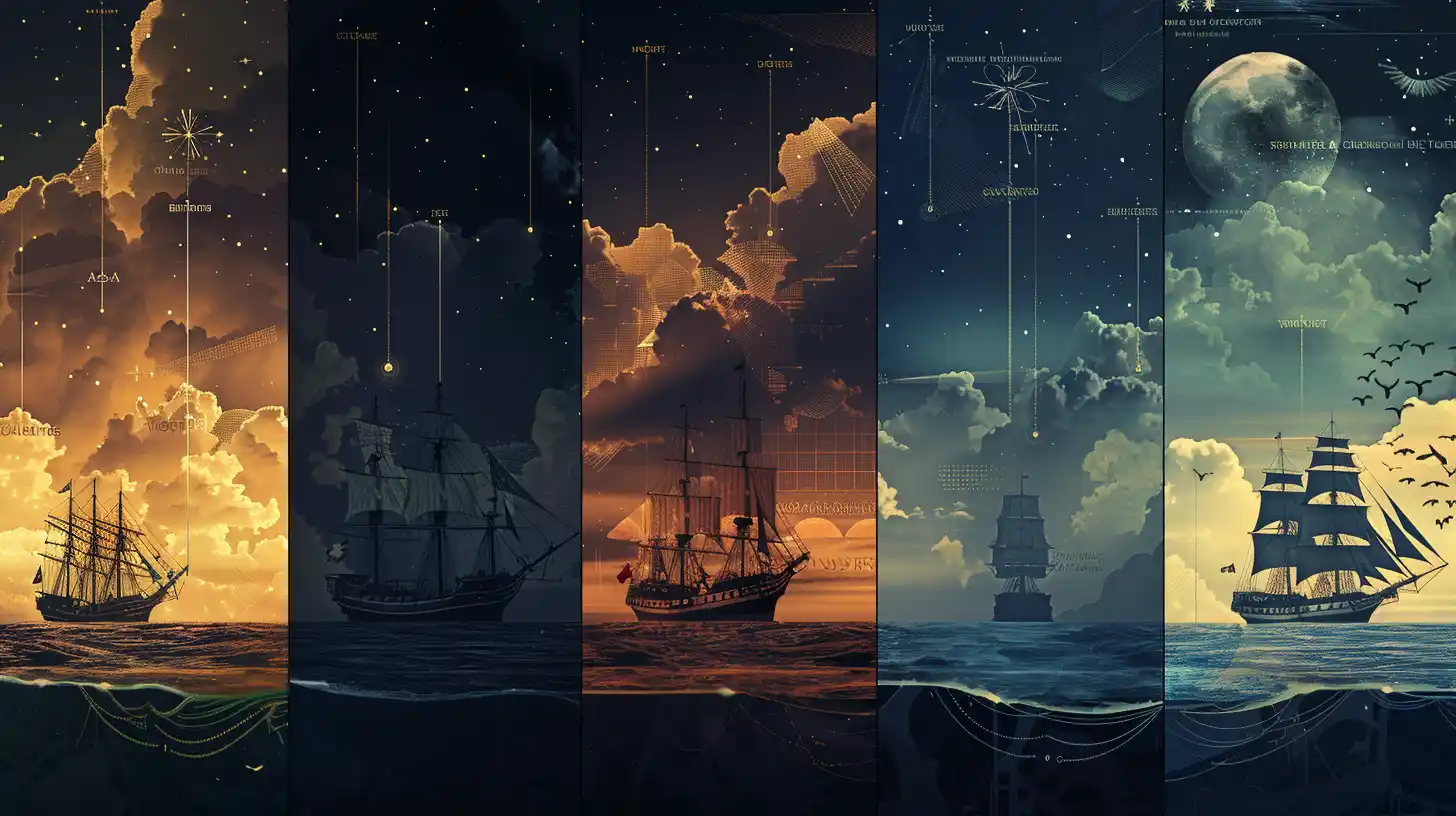Maritime Evolution
Have you ever wondered how ships at sea find their way? Or how the huge ships that carry our clothes, toys, and food across oceans have changed over time? The maritime industry—which means everything related to ships, oceans, and sea travel—has gone through amazing changes. From simple tools like the sextant (a tool sailors used to look at stars to find their way) to smart ships that can almost drive themselves, Maritime Evolution has happened in four big steps.

Maritime 1.0: The Age of Navigation in Maritime Evolution
The story of ships begins thousands of years ago. But what we call Maritime 1.0 really took shape when sailors started using special tools to find their way across vast oceans.
The most famous tool was the sextant. This clever device helped sailors figure out where they were by measuring the angle between the sun or stars and the horizon. Another important invention was the chronometer—a super accurate clock that helped sailors know how far east or west they had traveled.
During this time, brave explorers like Christopher Columbus used these tools to make amazing journeys. In 1492, Columbus sailed across the Atlantic Ocean and reached America, though he thought he had found India! Ships during Maritime 1.0 were mostly wooden and powered by wind using sails.
Maritime 1.0 lasted from ancient times until about the late 1800s. During this time, sailors relied on their skills, experience, and basic tools to cross dangerous seas.
Maritime 2.0: The Era of Mechanization
The next big change came when ships started using engines instead of just sails. This was Maritime 2.0—the time when ships became mechanized.
The biggest change was the invention of steam-powered ships. Instead of waiting for the wind, these ships could move using steam engines. In 1819, a ship called the SS Savannah became the first steamship to cross the Atlantic Ocean.
Other important inventions during this time were:
- The screw propeller, which replaced paddle wheels and made ships faster
- The diesel engine, which was more efficient than steam engines
The launch of a ship called the Vandal in 1903 marked another important moment—it was the world’s first diesel-electric ship!
Maritime 2.0 lasted from the early 1800s to the middle of the 1900s. During this time, ships became bigger, faster, and more reliable than ever before.

Maritime 3.0: The Digital Age
After engines changed ships, computers changed how sailors navigated and managed their vessels. This was Maritime 3.0—the digital age of shipping.
During this time, electronic navigation systems replaced many of the old tools. Instead of using a sextant and maps, sailors could now use GPS (Global Positioning System) to know exactly where they were.
Two important systems developed during Maritime 3.0 were:
- The Automatic Identification System (AIS): This lets ships send out signals showing their position, speed, and direction. It helps prevent crashes between ships.
- The Electronic Chart Display and Information System (ECDIS): This replaced paper maps with digital ones on computer screens.
Maritime 3.0 started in the late 1900s and continued into the early 2000s. These digital tools made sailing safer and more efficient than ever before.
Maritime 4.0: The Era of Industry 4.0
Today, we are living in the time of Maritime 4.0. This is the newest and most exciting phase of maritime evolution! Maritime 4.0 takes the digital systems from Maritime 3.0 and makes them even smarter by connecting them together.
Maritime 4.0 is part of what grown-ups call “Industry 4.0″—a fancy term for making machines smarter by connecting them to the internet and each other. In the shipping world, this means using cool technologies like:
- IoT (Internet of Things): Putting sensors all over ships that can send information about how the ship is working
- AI (Artificial Intelligence): Computer programs that can think and make decisions almost like humans
- Blockchain: A super secure way to keep track of information
The most exciting developments in Maritime 4.0 include autonomous ships (ships that can sail themselves), smart systems that can predict when parts might break before they actually do, and real-time tracking of cargo as it moves around the world.
The Role of AI in Maritime 4.0 Operations
AI (Artificial Intelligence) is like a super-smart computer brain that can learn and make decisions. In Maritime 4.0, AI is changing everything about how ships work.
Here are some ways AI helps in modern shipping:
Predictive Maintenance: AI can look at information from sensors on a ship’s engine and predict when something might break. This means fixing problems before they cause bigger troubles!
Autonomous Navigation: Some newer ships can partly drive themselves using AI that can “see” other ships, bad weather, and obstacles in the water.
Fuel Optimization: AI can figure out the best routes and speeds for ships to use less fuel. This saves money and is better for the environment too.
AI works by analyzing huge amounts of data much faster than any human could. It uses something called machine learning algorithms—special programs that get smarter over time as they see more information.
Timeline of Maritime Evolution
1.0 (Ancient times to late 1800s):
- 1492: Christopher Columbus sails to America
- 1700s: Invention of the sextant
- 1903: Launch of the Vandal, the first diesel-electric ship
2.0 (Early 1800s to mid-1900s):
- 1819: SS Savannah becomes the first steamship to cross the Atlantic
- 1830s: Development of the screw propeller
- Early 1900s: Introduction of diesel engines
3.0 (Late 1900s to early 2000s):
- 1990s: Introduction of the Automatic Identification System (AIS)
- 2000s: Implementation of the Electronic Chart Display and Information System (ECDIS)
Maritime 4.0 (Current):
- Development of autonomous ships
- Use of AI for predictive maintenance
- Implementation of IoT for real-time monitoring
- Integration of blockchain technology
The journey from simple sextants to smart ships is amazing! As technology continues to develop, Maritime 4.0 will keep making shipping safer, more efficient, and better for our planet. The next time you see a big container ship in a harbor or pictures of old sailing ships, remember the incredible story of maritime evolution that connects them!


Leave a Reply